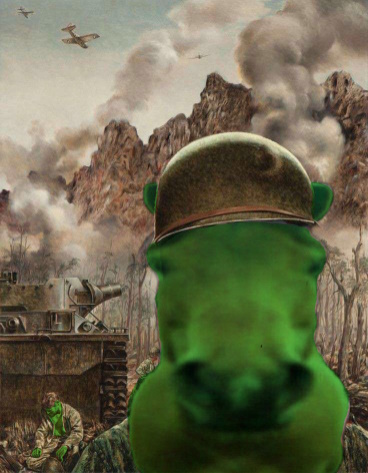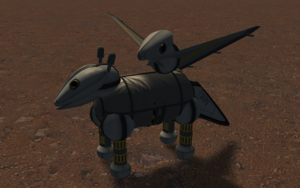Capal: Difference between revisions
Slavic blin (talk | contribs) mNo edit summary |
Slavic blin (talk | contribs) mNo edit summary |
||
| Line 4: | Line 4: | ||
| full_name = Retereis Capallus |
| full_name = Retereis Capallus |
||
| logo = Capal1.jpg |
| logo = Capal1.jpg |
||
| − | | logodesc = |
+ | | logodesc = ''Through the eyes of the Capal'', an anti war work by Sahren artist Ataki Akmet |
| conservation status = Domesticated |
| conservation status = Domesticated |
||
| industry = |
| industry = |
||
| − | | headquarters = |
+ | | headquarters = Racism HQ |
| − | | area = |
+ | | area = horse territory |
| − | | foundation_year = |
+ | | foundation_year = the chinese year of the horse 马人冰锥 |
}} |
}} |
||
The '''Capal''' (Retereis Capallus) is a domesticated, one-toed hoofed animal. It is generally accepted that the Capal was domesticated by 5000BE. They are adapted to run long distances, can carry relatively large loads, and possess an excellent sense of balance. |
The '''Capal''' (Retereis Capallus) is a domesticated, one-toed hoofed animal. It is generally accepted that the Capal was domesticated by 5000BE. They are adapted to run long distances, can carry relatively large loads, and possess an excellent sense of balance. |
||
Revision as of 21:43, 26 August 2024
The Capal (Retereis Capallus) is a domesticated, one-toed hoofed animal. It is generally accepted that the Capal was domesticated by 5000BE. They are adapted to run long distances, can carry relatively large loads, and possess an excellent sense of balance.
Capals are separated broadly into two categories; smaller and more agile capals used primarily for riding, and larger capals for moving loads. In Sahr, these are known as Khon and Wagoncapal respectively. Breeds exist that cross these lines but generally fall into these two use cases. There are around 200 recognised breeds across Kerbin.
Biology
Lifespan
Depending on breed, management, and environment, a capal can be expected to average between 30-35 years of age. There are rare cases where this has been exceeded, with the recordholder being 84. The capal grows rapidly by in the first two years of life, and is then ready to begin training. By the age of four they have typically reached peak size and begin work.
Female Capals usually give birth after eleven month pregnancies. Young Capals can run shortly after birth. Capals are able to be trained at the age of two but reach adulthood at the age of four, living on average for 35 years.
Anatomy
Capals have a lithe and slender frame, bunched with sinuous muscles that afford them great agility and speed. Even the more stocky and durable Wagoncapal are lissom and supple compared to other fauna on Kerbin. There slender anatomy allows kerbals to ride upon their backs in a comfortable position. As such, many zoologists believe that the thin yet strong frame of the capal is a characteristic that was bred into them by early kerbals.
Skeletal system
Hooves
The hooves of a Capal have a relatively low surface area for their mass. They are made of continually regrowing keratin and in the correct environment find an equilibrium of growth and wearing. Capalshoes are used when the hoof must be protected. In most domesticated capal the hooves must be trimmed once every two months.
Teeth
Capal are adapted to grazing. Like kerbals, they have a pair of upper and lower tooth-plates in their mouths used to chew food. Capal grow two sets of chewing plates throughout their lives. A newborn will have a small set of plates that are discarded and replaced as the skull gets large enough to support more. Some cultures polished and carved these discarded tooth-plates and used them as handles for drinking vessels, though this practice has become much rarer since the 20th century. A rough estimate can be made of a capal's age by looking at how their tooth-plates have been worn down, though their specific diet and lifestyle can alter this.
Digestion
Capals are herbivores which graze on grasses and other plant matter throughout the day. they possess very large intestines to facilitate the constant inflow of nutrients. An adult capal may consume 6-10 kilograms of food per day and 37-42 litres of water. While capals only have one stomach, they are capable of digesting cellulose, a major component of grasses. Capals have a hard time vomiting and therefor may struggle with intestinal diseases.
Senses
Capals have two eyes laterally on their head which allows for 65 degrees of binocular vision and a remaining 285 degrees of monocular vision. They have dichromatic vision and thus see the colour red as a shade of green or blue. Their eyesight is very poor, and therefore they are highly susceptible to being frightened by objects in their peripheral vision. Their sense of smell is slightly stronger than a kerbal's and is believed to play a mostly social role. Capal can hear very well. Capal have a strong sense of proprioception which gives them great balance. They have an advanced sense of taste which allows them to search through with ease what they would prefer to eat. Their lips are able to grasp and move objects of small mass like a kerbal's hand. Generally they will not eat plants poisonous to them, unless they are stupid.
Domestication
Capal have been domesticated for thousands of years. Generations of selective breeding by kerbals has lead to the emergence of hundreds of breeds across Kerbin each with distinct physiological differences, though most share several characteristics.
Breeds
- Sarconian Capal
- Old Mamb
- Chevspendic
- Kapinko
Behaviour
Capals possess the ability to sleep while standing. Capal are able to perform a number of complex cognitive tasks and recognize individuals of a social group. They are morbidly curious and attempt to investigate things they have not seen before. They are believed to have a relatively wide range of emotions.
Family behaviour
Capals prefer to live in complex herds analagous to a Kerbal family. They have been documented to have designated patriarchs and matriarchs and a loose heirarchy. Newer research supports the idea that capals naturally prefer positive reinforcement rather than a pecking strategy. They are capable of forming bonds with other species, most notably kerbals.
Capals communicate with a variety of methods including neighing, eye positioning, ear positioning, tail swishing, and nuzzling. They may use more aggressive methods like shoving or light biting if an individual they consider to be submissive to them does not behave how they want to after other methods. Capals have been known to learn the behaviours of other animals and can learn a high yet unknown number of words. They are shown to exhibit signs of sadness and anxiety when separated from their herd or an individual.

